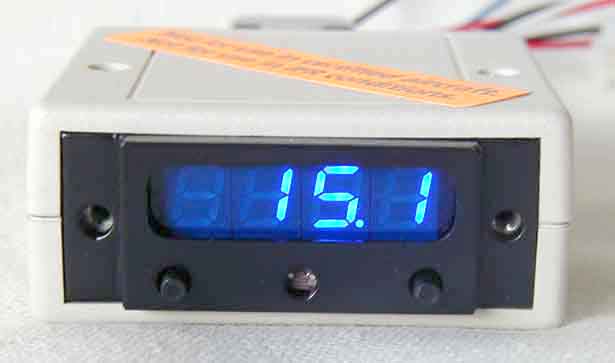
The MPG meter normally displays instantaneous mileage. You can easily switch the display to indicate statute miles per gallon, nautical miles per gallon, or liters per 100 kilometers. At the touch of a button it will also display fuel flow, ground speed or engine hours since installed. The display is bright blue, but dims automatically based on cockpit light level.
The MPG meter is not a fuel totalizer. It does not keep track of fuel used, fuel remaining, etc. It is a simple display of mileage that is easy to install and that takes very little panel space. The meter requires a fuel flow transducer to determine fuel flow. It will accommodate two transducers for those aircraft that have one on the feed line and one on the return line. It can either share the signal from the fuel transducer(s) with your existing totalizer, or retransmit the fuel flow signal to your totalizer after applying a correction factor. The connection from the MPG meter to your fuel totalizer uses optical coupling, which isolates the two systems and avoids wiring and grounding conflicts between the two. This makes installation very straightforward.
The meter requires a GPS or LORAN receiver to determine speed. Any GPS receiver that has a data output will work. Any panel mounted receiver, any aviation or marine hand-held receiver, even a GPS engine such as a the Garmin models 16, 17, 18, 19, 35 or 36 will work. The MPG meter decodes the standard protocol messages produced automatically by these GPS receivers. The MPG meter can share the receiver's output with other devices.
Porcine can supply the necessary the fuel flow transducer if one is not already installed in your aircraft. Porcine can also supply a suitable Garmin GPS engine. This is a self-contained receiver/antenna that you can dedicate to the MPG Meter and permanently mount in your aircraft. Details here. You can alternatively use your existing navigation GPS receiver for a data source.
The meter normally displays mileage( statute miles per gallon, nautical miles per gallon or liters per 100 kilometers). Use the buttons to change the display as shown in Table I below.
| Hold Down Button | Display shows: |
|---|---|
| None | Mileage |
| Left | Speed |
| Right | Fuel flow |
| Both | Hours of fuel flow |
Table I - Display choices
The Hours display shows hours and tenths up to the maximum of 999.9 where it will roll over to zero and start counting up again.
You can choose to display the data using the units shown in Table II below. During setup you choose the default set of units. During flight you can temporarily switch to another set if desired.
| ID |
mileage units | speed units | fuel flow units |
|---|---|---|---|
| Stat | statute miles per gallon | statute miles per hour | gallons per hour |
| Naut | nautical miles per gallon | knots | gallons per hour |
| Kilo | liters per 100 kilometers | kilometers per hour | liters per hour |
Table II –Units
There are two calibration values.
During setup you enter these constants using the buttons on the MPG Meter. Once set they are retained indefinitely. There are no batteries in the MPG Meter and it does not require a constant connection to the battery. Data retention for constants is in excess of 20 years. You can re-enter the constants to make adjustments very easily at any time.
Voltage:
10-30V
Dimensions: 0.9"H x
1.55"W panel cutout
1.0"H x 2.4"W x 2.3"D clearance behind the panel (not including
connector, add 1.6" including strain relief)